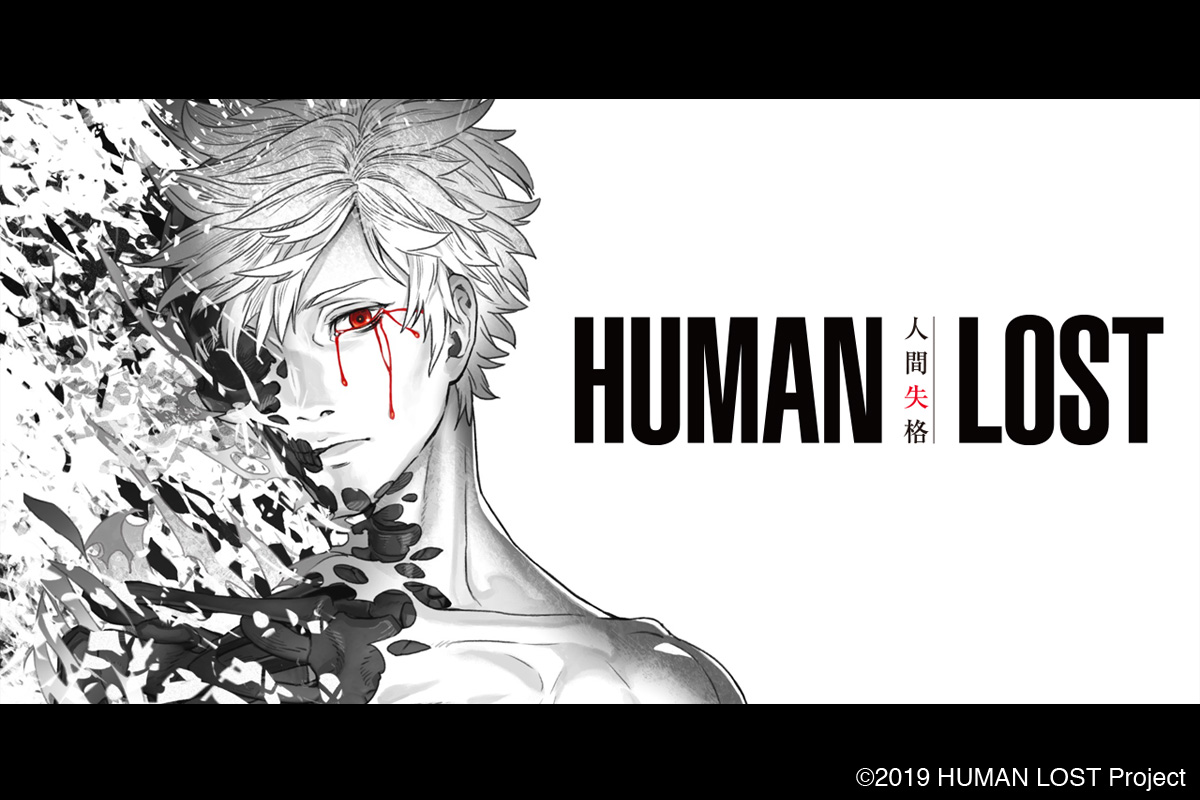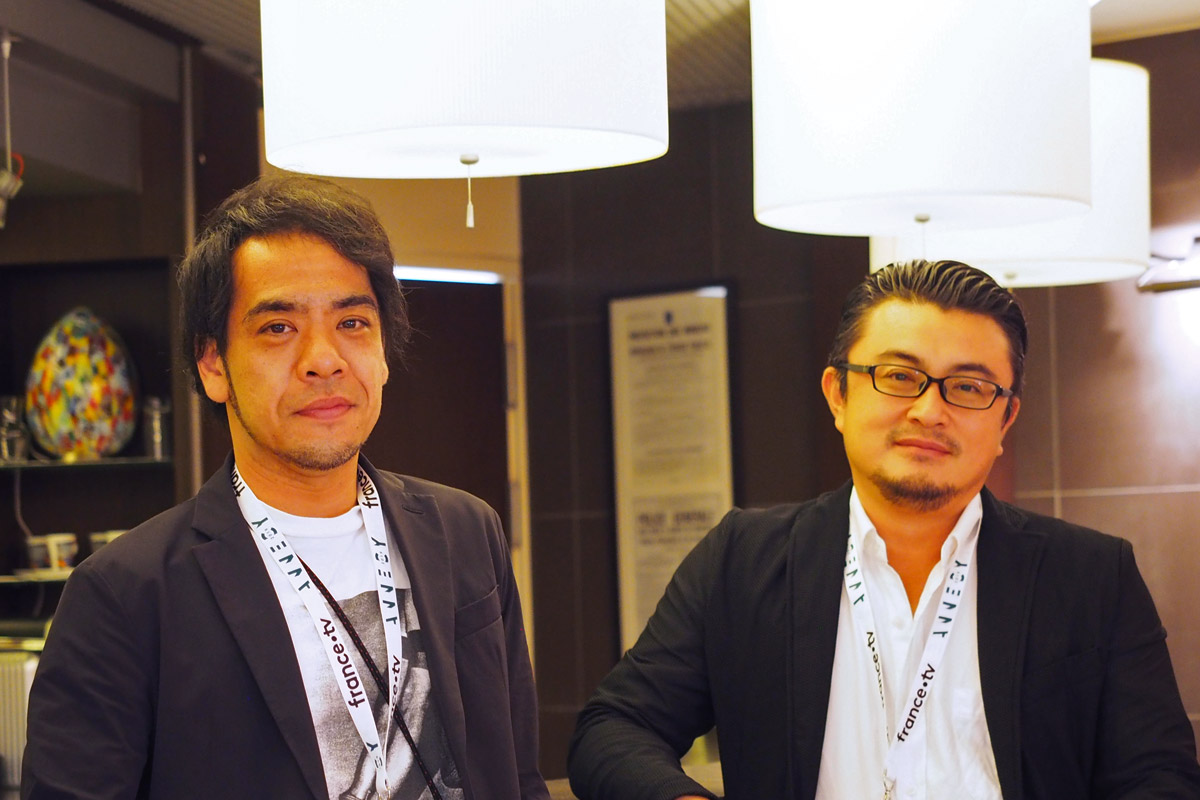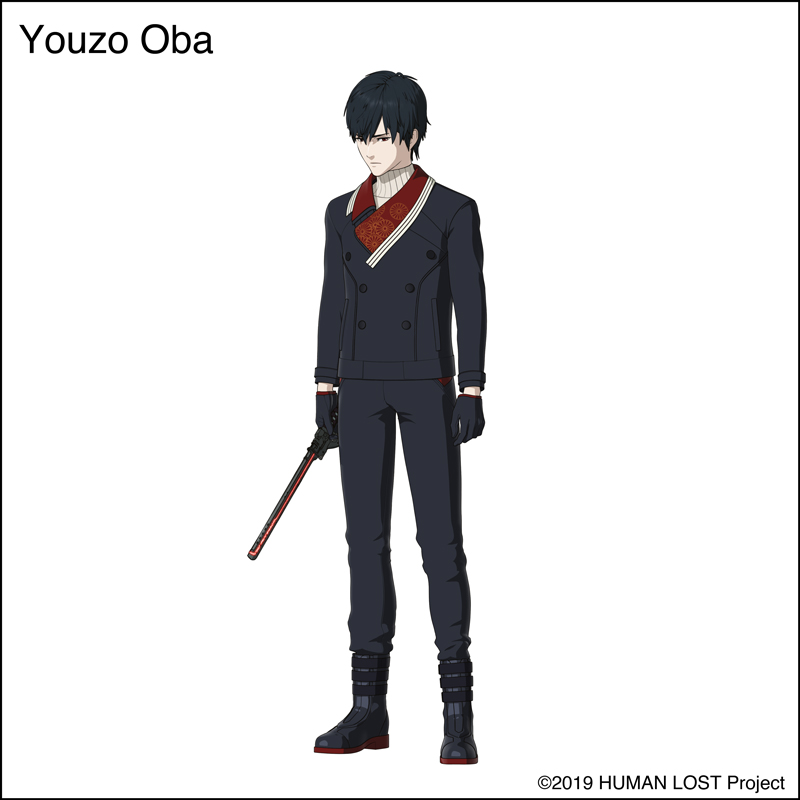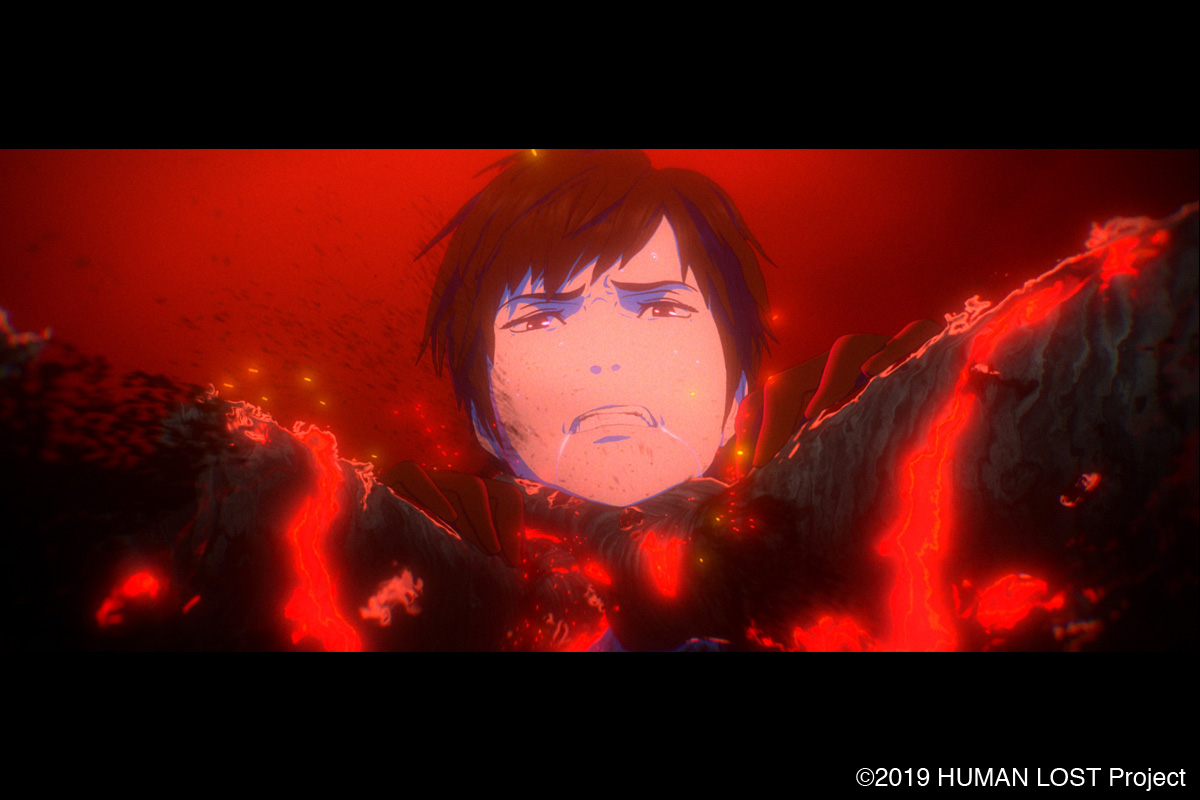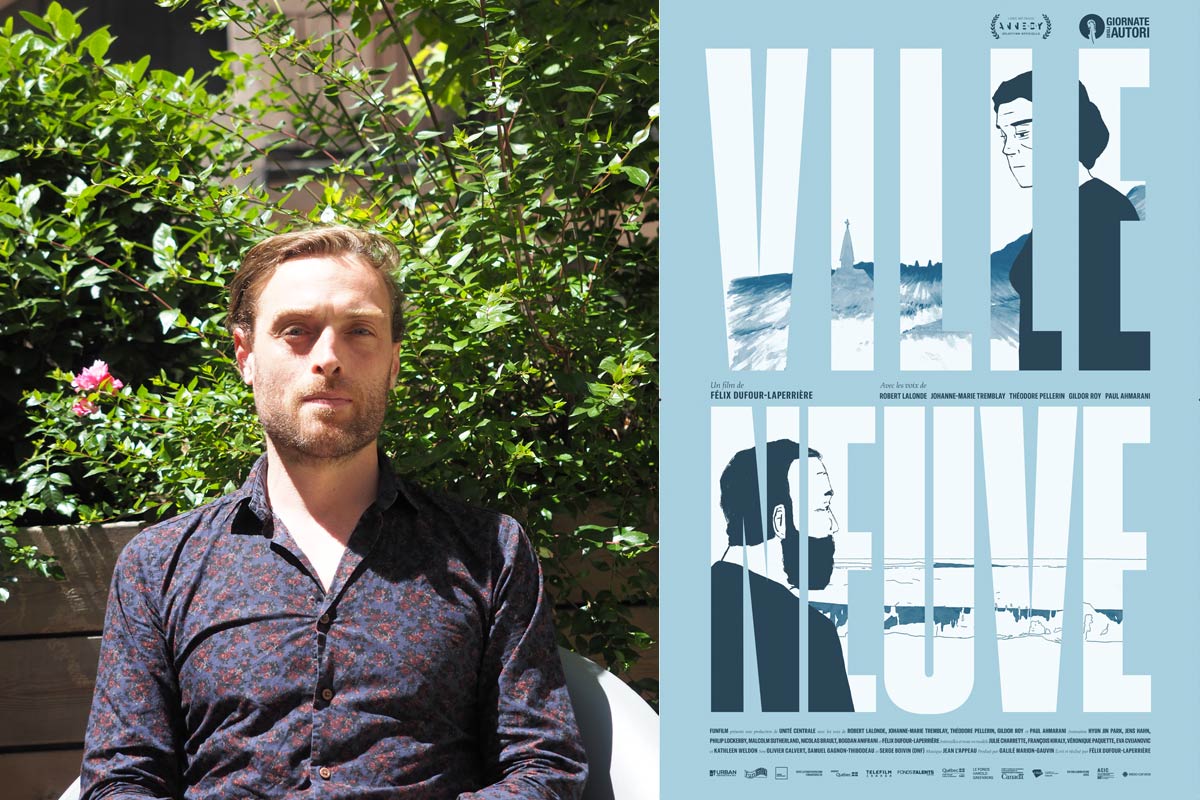HUMAN LOST
The concept of the story: No Longer Human by Osamu Dazai
Supervisor: Katsuyuki Motohiro
Director: Fuminori Kizaki
Author of the original story, Scriptwriter: Tow Ubukata
Character Designer: Yusuke Kozaki
Concept Artist: Kenichiro Tomiyasu (INEI)
Animation Production: POLYGON PICTURES
Planner, Producers: MAGNET / SlowCurve
The world Premiere of the Japanese animated feature HUMAN LOST was held at the Grande Salle theater in Bonlieu, the main venue of the Annecy International Animated Film Festival 2019, on the evening of 14th June. It is an sci-fi action film which was developed for the international market as its main target, and the concept of the film story is based on No Longer Human (1948) written by Osamu Dazai, a very famous classical author in literature in Japan. The film had its North American premiere on 5th July. Both of the special screenings became the unveiling events of the film ahead of its theatrical release in Japan.
HUMAN LOST was developed by a team of two world-renowned names, Fuminori Kizaki, the director, and POLYGON PICTURES, a leading 3D animation studio in Japan, which deserves its right to target the global market. Mr. Kizaki is receiving high international reputation through his great works, such as the TV animation series Basilisk (2005) and Afro Samurai (2007), and an animated feature BAYONETTA Bloody Fate (2013). POLYGON PICTURES has been developing many global-hit TV series such as Star Wars: The Clone Wars (2011-13), Transformers: Prime (2010-13) and Knights of Sidonia (2014-15).
Animationweek had the opportunity to hear about the film from Mitsugu Iwano (MAGNET, Japan), the chief producer, and Toshiaki Obata (SlowCurve, Japan), the producer, just before the world premiere. We are happy to be able to share their words with you.
Interview with Mitsugu Iwano and Toshiaki Obata
Hideki Nagaishi (HN): Could you please let us know how did the film project start?
Mitsugu Iwano: I had been thinking that I would like to make an animated feature for the international market because I have a personal wish: Japanese animation creators should be recognized more highly in the world and they deserve that. I was also thinking that if the global market values the film highly like it did with Akira (1988) and Ghost in the Shell (1995), it would not be a problem if the Japanese market did not appreciate the film at all.
While I was thinking like that, Mr. Obata suggested to me to make a new film together, so I told him: “I would like to make a film of a dark hero’s story and set its international theatrical release prior to its premiere in Japan.” Then, he replied: “In that case, how about making a sci-fi action film with a story of a dark hero based on Osamu Dazai’s novel No Longer Human.” I answered: “Let’s make it together!” This was the start of the animated feature project.
HN: I’m interested in the reason why you wanted to make an animated feature based on No Longer Human.
Toshiaki Obata: Actually, the reason why I started this film was almost the same as Mr. Iwano. My passionate thoughts were: “I would like to deliver a good Japanese sci-fi animated feature to the world, which will follow Akira and Ghost in the Shell and have a big impact on the global audience, the way these two films did.”
Regarding the reason why I selected No Longer Human as the original concept for developing the story of this film, there are two major reasons.
Firstly, I thought that if we reboot the story of No Longer Human, one of the most-read Japanese classical literature in Japan, as a sci-fi, it would be a very interesting story.
Another reason was that I thought that the theme “the individual and society”, which commonly underlies Dazai’s novels at a fundamental level, could be a very vivid theme of the film to the current global society. Social media is dominating the world now, so I feel that there is a large number of young people who seemingly do not know what they really like and what is truly important for them, and just follow and adapt to the atmosphere around them. It can be said that their individualities are being taken away from them, in a sense. I think that is one of the symbolic characteristics of young people in the current global society, and there is an overlap between that characteristic and the protagonist’s character in No Longer Human, Youzo Oba, who is spending his life following his surroundings without acting by his own will. So, I thought that it would be interesting if we were to adapt the figure of Oba to the story of this film.
HN: The original novel No Longer Human describes the life of a down-going man, Youzo Oba, from his childhood to his adolescence, who tries to put on a false persona to adapt to human society and immerses himself in alcohols, drugs and women. On the other hand, the setting of the film is in the future with technology of great scientific advancements and big arrangements were made to the story. How did you develop the original story of the film?
Toshiaki Obata: At the beginning of the project, Mr. Iwano, Katsuyuki Motohiro and I drafted the film project to arrange the story of No Longer Human into a sci-fi, like Akira and Ghost in the Shell, and brushed up the idea of the story. Then Tow Ubukata, the Scriptwriter, and Kenichiro Tomiyasu, the concept artist, took part in the team and the story became more concrete at an accelerating pace. The person who elaborated the story and universe the most is Mr. Ubukata. We finalized the story whilst the visuals of the universe were being developed by Mr. Tomiyasu with discussions like “What does this world look like?” So, this is the story in which all of the core project members developed together through a wide variety of discussions.
HN: An official press release of the film says that the main staff of this film are special and the names appear as following: Mr. Kizaki (Director), Mr. Ubukata (Scriptwriter), Mr. Motohiro (Supervisor), Mr. Kozaki (Character Designer) and Mr. Tomiyasu (Concept artist). Could you please let us know why and how did these five famous creators take part in the film project?
Toshiaki Obata: The only member of this film who already decided to take part from the beginning of the project is Mr. Motohiro, among the names you’ve mentioned. Mr. Motohiro is famous for his direction of live action films and TV series such as the Bayside Shakedown franchise. On the other hand, Mr. Motohiro loves animation, so I have been thinking that I would like to make an animated feature with an original story together with him. Hence, he was the first person I shared the idea of arranging No Longer Human into a dark hero’s story with.
Mitsugu Iwano: Then the director Mr. Kizaki took part in the team. We were talking about who are the Japanese animation directors that are being well-recognized worldwide for developing a film that is acceptable for the international market, and his name was listed as the director of the globally famous Afro Samurai. We asked Mr. Obata to contact Mr. Kizaki and he joined the project.
Toshiaki Obata: After that we invited Mr. Ubukata and Mr. Tomiyasu, who are wise in sci-fi, to join the team almost at the same time. We asked Mr. Ubukata to work together with us when we were in the stage of writing the plot of the film and he developed not only the plot but also the visuals of its universe with Mr. Tomiyasu.
Mr. Kozaki joined last among the creators you mentioned. The reasons why I asked him to join this film project were:
Firstly, I was thinking that it is good to have a shining and splendid visual design of the characters, like his visual style, in the heavy and deep sci-fi world of this film.
Secondary, I really inherently like his illustrations.
Thirdly, his has designed characters for video games and I felt that the formative design of his characters, which is not the distinctive Japanese-animation character with big eyes, is an internationally acceptable style of art. So, I thought his characters are good for this film project.
HN: How was the production studio of the film decided to be POLYGON PICTURES?
Mitsugu Iwano: Of course, it was one of the things we had to decide in the first stage of this film project; whether we would make the film as a traditional 2D animation or as 3D CGI. And Mr. Obata suggested to me: “Let’s go with 3DCGI.” Then, I replied: “If 3D CGI, what studio are we going to work with?” And he said: “How about POLYGON PICTURES?” This was a brief recount of the kind of discussion we had.
Toshiaki Obata: We, SlowCurve, was one of the members of the TV animation series project Knights of Sidonia, in which POLYGON PICTURES created the animation. When POLYGON PICTURES was making Knights of Sidonia, they were also making the pilot of the animated feature BLAME! (2017) at the same time so that I could see their greatness of expressing the universe of both sci-fi works next to them. All the time since then I wanted to work with them. And, I think it is needless to say, but POLYGON PICTURES, which has an international reputation, is the best Japanese studio to collaborate with for a film project aiming for the global market. So, I asked Hideki Moriya, vice president of POLYGON PICTURES, directly.
HN: Could you please let us know what you think are the attractive points or the highlights of this film?
Mitsugu Iwano: As I told you, I produced this film because I wanted to make a film of a dark hero. And I think action scenes are very important elements for a dark hero story. As you know, Mr. Kizaki is a director who is famous for the greatness of action scenes in his works. Actually, this is his first 3D CGI animation, but he completed a lot of spectacular action scenes, which are definitely worth seeing, together with POLYGON PICTURES through much effort. So, I hope indeed that the audience will enjoy the action scenes in the film.
Toshiaki Obata: As with Mr. Iwano, action scenes are the big attractive points of this film. I also think that Youzo Oba’s wavering heart and emotions are also the highlights of this film. He faces variety of fates and trials, and then he chooses the path of his life by himself for the first time in his life. I feel that currently the number of young people who live a predetermined life or someone else’s life is increasing. So, I would be happy if the human drama, where Mr. Oba makes the decision of his path for the very first time, will reach the hearts of the young audience.
HN: What kind of experience or message do you want to deliver through this film?
Mitsugu Iwano: It’s a bit technical, but we could accomplish visualizing and animating the 3D CGI characters almost the same way as in traditional hand-drawn 2D animation. There are many scenes where you might think: “I can’t tell whether this is a 2D animation or 3D animation.” The visual experience of the 2D-animation-style 3D CGI POLYGON PICTURES achieved is outstanding, so I want the audience to look at it carefully.
Toshiaki Obata: Since I told you that I wanted to make this film as a strong sci-fi title, where people will list it next to Akira and Ghost in the Shell, I hope the global audience will have a positive impression, which can match their impressions of the two films. For example, “Oh, a sharp sci-fi animation has arrived for the first time in many years”, “There hasn’t been this kind of animation since Akira”, and so on. I would be very happy if they have these kinds of impressions from our film.
As I mentioned about the protagonist, Youzo Oba, a little while ago, I want the audience to be able to find something inside the characters in this film that they see in themselves as well, and it remains in their heart and makes them think about it. I hope they will bring back that kind of feeling from the theater after watching the film.
Of course, the action scenes in this film are great, so I think they are enjoyable to watch.
Mitsugu Iwano: We don’t intend to make the audience feel refreshed by watching this film, so I believe each audience will find at least one thing in this film which makes them think “hmm…”
Story
“Mine has been a life of much shame.”
Tokyo, 2036 (Showa year 111): a revolution in medical treatment has conquered death…
By means of internal nanomachines and the “S.H.E.L.L.” system whose network controls them, human beings suffer no diseases, require no treatment for injuries, and are guaranteed a 120-year lifespan, free from illness.
Yet this consummate social system warps the Japanese nation in a host of ways: unresolved economic disparities, ethical decadence resulting from deathlessness, grave environmental pollution, and the “Human Lost” phenomenon, in which people themselves, disconnected from the S.H.E.L.L. network, become malformed.
Japan teeters wildly between two potential futures: civilization’s restoration, or its destruction.
Atmospheric pollution suffuses “Route 16” in the Outside–the area outside the Route 16 beltway. Yozo Oba, who lives an idle, drug-saturated life, joins Masao Horiki, a mysterious man who associates with the drag-racing gangs, on an incursion Inside–the area within the Route 7 loop where the privileged class lives–only to be embroiled in a violent struggle. When he encounters a malformed sufferer of the Human Lost phenomenon, a “Lost,” Yozo’s life is saved by Yoshiko Hiiragi, a girl of mysterious abilities who belongs to the anti-Lost agency H.I.L.A.M., and he discovers that he himself also possesses extraordinary powers…
Degradation and death. Life and hope. Buffeted by fate, a man tears himself apart and cries out. Rage. Sorrow. Pathos. Consumed by despair and bitter tears, Yozo Oba is himself transformed into a demon.
A human lost… or a human who can find himself?



